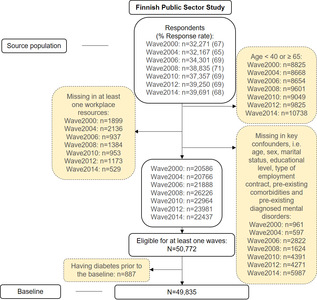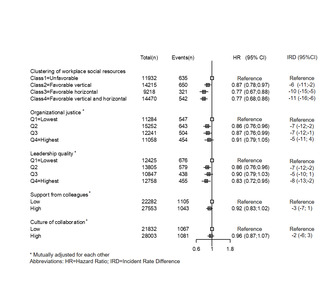Alhainen, Maria;
Härmä, Mikko;
Pentti, Jaana;
Ervasti, Jenni M;
Kivimäki, Mika;
Vahtera, Jussi;
Stenholm, Sari;
(2022)
Sleep duration and sleep difficulties as predictors of occupational injuries: a cohort study.
Occupational and Environmental Medicine
, 79
(4)
pp. 224-232.
10.1136/oemed-2021-107516.

![[thumbnail of Figure 1.bmp]](https://discovery.ucl.ac.uk/10149797/2.hassmallThumbnailVersion/Figure%201.bmp)  Preview |
Text
Figure 1.bmp - Other Download (3MB) | Preview |
![[thumbnail of Figure 2.bmp]](https://discovery.ucl.ac.uk/10149797/3.hassmallThumbnailVersion/Figure%202.bmp)  Preview |
Text
Figure 2.bmp - Other Download (3MB) | Preview |
![[thumbnail of Figure 3.bmp]](https://discovery.ucl.ac.uk/10149797/4.hassmallThumbnailVersion/Figure%203.bmp)  Preview |
Text
Figure 3.bmp - Other Download (3MB) | Preview |
Preview |
Text
Kivimaki_Xu_workplace_psychosocial_resources_diabetes_risk.pdf Download (275kB) | Preview |
Preview |
Text
Kivimaki_Appendix_diab_revised_3.pdf Download (1MB) | Preview |
Abstract
STUDY OBJECTIVES: To examine the association between sleep duration and sleep difficulties with different types and causes of workplace and commuting injuries. METHODS: The data were derived from the Finnish Public Sector study including 89.543 participants (178.309 person-observations). Participants reported their sleep duration and sleep difficulties between 2000 and 2012. These were linked to occupational injury records from the national register maintained by the Federation of Accident Insurance Institutions. Risk of injuries was followed up 1 year after each study wave. Logistic regression analysis with generalised estimating equations (GEEs) was used to examine the association between sleep duration/difficulties and risk of injuries, and multinomial logistic regression with GEE was used to examine the association with injury types and causes. RESULTS: Both sleep duration and difficulties were associated with injuries. Employees with short sleep (≤6.5 hours) had 1.07-fold odds of workplace injuries (95% CI 1.00 to 1.14) and 1.14 times higher odds of commuting injuries (95% CI 1.04 to 1.26) compared with employees with normal sleep duration. For employees with disturbed sleep, the corresponding ORs were 1.09-fold (95% CI 1.02 to 1.17) and 1.14-fold (95% CI 1.04 to 1.26) compared with those without sleep difficulties, respectively. The risk of commuting injuries was higher among those who had difficulty in falling asleep (OR 1.29, 95% CI 1.07 to 1.55), woke up too early (OR 1.11, 95% CI 1.00 to 1.23) or had non-restorative sleep (OR 1.18, 95% CI 1.05 to 1.33). CONCLUSIONS: Short sleep duration and sleep difficulties are associated with slightly increased risk of workplace and commuting injuries.
| Type: | Article |
|---|---|
| Title: | Sleep duration and sleep difficulties as predictors of occupational injuries: a cohort study |
| Location: | England |
| Open access status: | An open access version is available from UCL Discovery |
| DOI: | 10.1136/oemed-2021-107516 |
| Publisher version: | https://doi.org/10.1136/oemed-2021-107516 |
| Language: | English |
| Additional information: | This version is the author accepted manuscript. For information on re-use, please refer to the publisher’s terms and conditions. |
| Keywords: | accidents, occupational health, sleep, transportation |
| UCL classification: | UCL UCL > Provost and Vice Provost Offices > School of Life and Medical Sciences > Faculty of Population Health Sciences > Institute of Epidemiology and Health > Epidemiology and Public Health UCL > Provost and Vice Provost Offices > School of Life and Medical Sciences > Faculty of Population Health Sciences > Institute of Epidemiology and Health UCL > Provost and Vice Provost Offices > School of Life and Medical Sciences |
| URI: | https://discovery.ucl.ac.uk/id/eprint/10149797 |
Archive Staff Only
 |
View Item |


